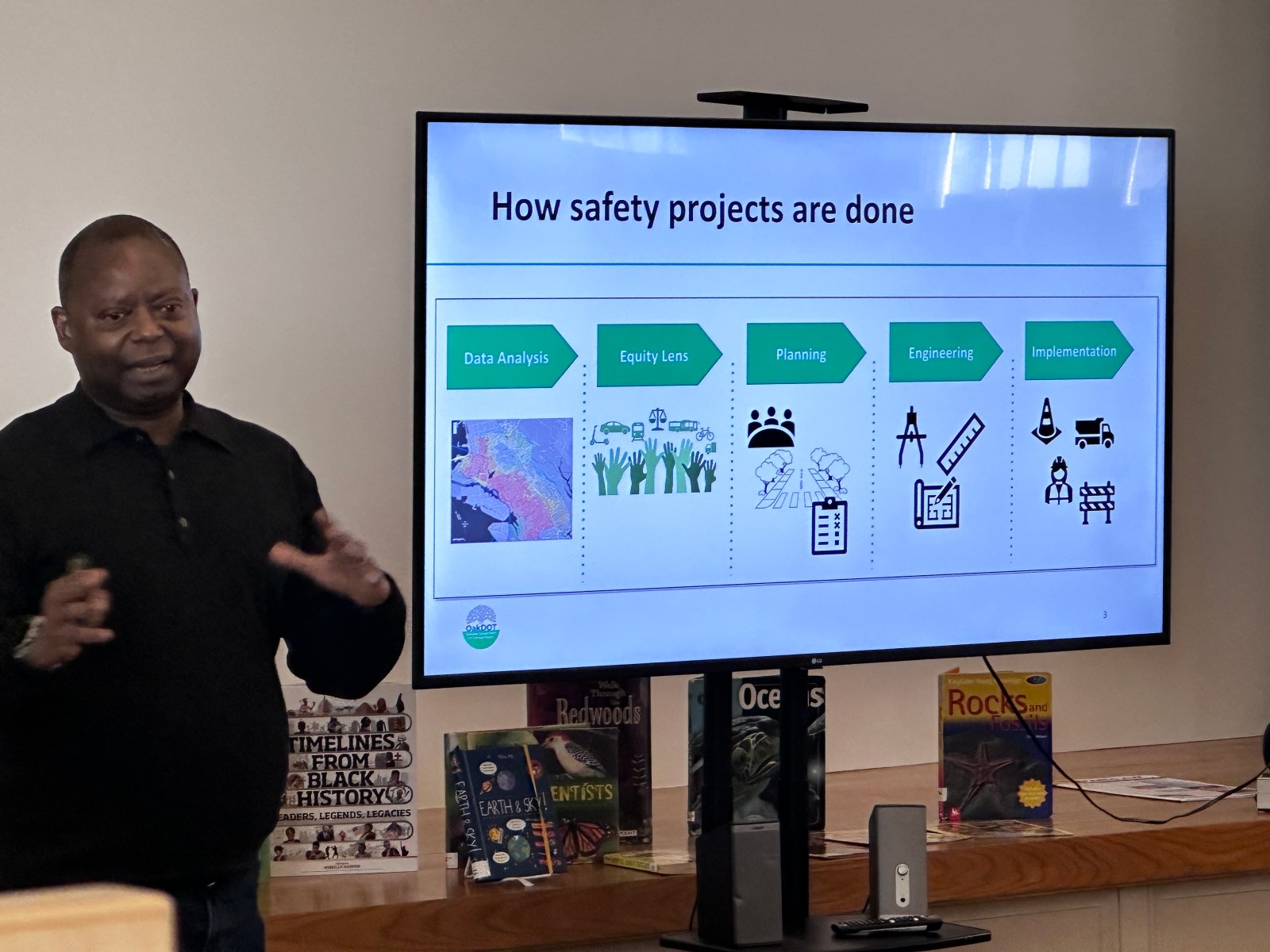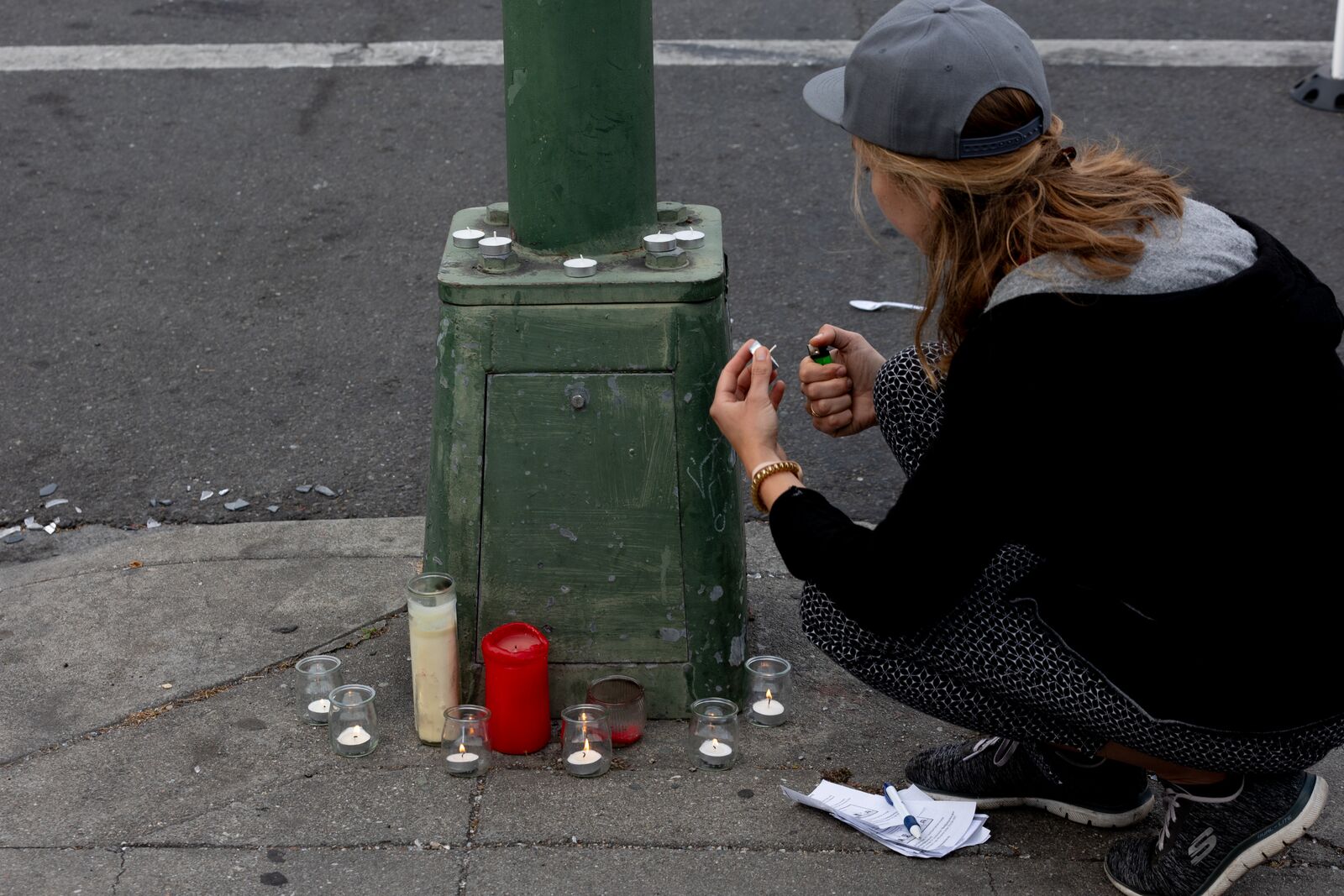Last December, the City Council urged the Transportation Department to find ways to quickly approve “encroachment permits” so that community groups—schools, neighborhoods—could rapidly add temporary infrastructure to roads to make them safer. This could involve adding things like a crosswalk, cones, bollards, signs, or other changes to slow traffic and help pedestrians and bicyclists avoid speeding cars.
This week, the Transportation Department presented an informational report to the council’s Public Works and Transportation Committee to describe how it thinks this program could work. But the department’s proposal disappointed advocates who say it won’t allow for fast enough action and that it would limit the number of places these kinds of safety interventions could happen.
Senior engineer Reginald Bazile told the committee that OakDOT is willing to work with passionate safe street advocates and anyone else who wants to get involved. He said OakDOT envisions a program where they could build up to ten new projects a year, including new intersection island roundabouts and curb extensions. The other option would be to not launch this kind of program and simply leave traffic safety interventions in the hands of city workers.
To create the community partnership program, planners and engineers would have to take time out of their scheduled work to determine the viability of each project “to make sure that it runs efficiently and safely,” said Bazile. They would approve project applications, create a tool-lending type library with approved materials, and oversee the work of volunteers. In other words, the city would have been deeply involved in each project, something that could be challenging given OakDOT’s lack of staffing and the city’s difficult budget situation.
“If you look across the landscape of tactical urbanism in the United States, you don’t see cities making it easy for members of the public to do what I would call audacious transportation safety projects in a right-of-way [like] narrowing lanes,” Bazile said. “You see more modest projects like curb extensions, establishing parklets, and closing down to do a block party. Many of those are things we already do in the city of Oakland.”
The report, authored by OakDOT Interim Director Megan Weir, was created in response to a request from District 3 Councilmember Carroll Fife.
Fife’s staff recommended creating a three-year pilot program with 90-day encroachment permits—basically permission slips from the city that would allow members of the community to add signage and safety infrastructure to roads. Advocacy organizations like Transport Oakland lobbied Fife to create the legislation, basing their work on successful encroachment permit programs in cities such as Columbus, Ohio, and the two-day crosswalk pilot in front of Oakland Tech created in response to a student being hit by a driver. These programs have been described as “tactical urbanism.”
Alice Chen from Transport Oakland said at Tuesday’s meeting that OakDOT’s report was “kind of a slow start and somewhat timid.” Residents who attended the city’s Bicyclist and Pedestrian Advisory Commission last week voiced similar criticism when Bazile presented there, saying OakDOT’s proposed number of projects is too low based on the city’s needs and that their engineering time estimates of about 100 hours per project is excessive.
OakDOT is concerned about equity impacts

Bazile said the department’s biggest worry is that working on volunteer-initiated projects could result in inequitable infrastructure distribution. Most people who have time to volunteer, he suggested, hail from more affluent neighborhoods and are more incentivized to fix issues in their own communities rather than help neighborhoods with fewer resources. East and West Oakland’s flatlands, the city has said, are historically underserved and bear most of the brunt of the city’s collision problems.
“This race and equity impact is compounded because the new program that’s inequitable would pull resources from the programs that are prioritized on race and equity,” Bazile said.
OakDOT staff wrote in their report that managing such a program could force them to postpone capital projects on Oakland’s most dangerous roadways, likely from the list of discretionary projects each council member directed funds for in the 2023-25 city budget. Potential project casualties, Bazile said, could include the Bay Place-Montecito Avenue temporary lane reduction slated for District 3 and the Market 4325321`Street/45th Street sideshow prevention project in District 1. This detail concerned council members Treva Reid and Kevin Jenkins, who sit on the committee.
Reid, who represents deep East Oakland, said the city should work to speed up traffic safety infrastructure but not at the expense of delaying projects that are sorely needed and years late. She also said she supported people who have already created off-the-books tactical urbanism projects, like school parents and teachers creating a crosswalk in front of Grass Valley Elementary School.
“I looked at the potential delay in canceling the race and equity impacts along the lines of speed bump programs, rapid response programs, safe routes to school programs, speed limit management programs, and traffic safety. That’s everything we’re talking about every day. In my district, we can’t afford any delay,” she said.
The activists who have worked on improving Oakland streets in the last few years are keenly aware of the unequal dangers different communities face when navigating Oakland’s roads. Groups like Traffic Violence Rapid Response have mostly focused their advocacy on underserved communities and roads they use, such as Fruitvale and International Boulevard in East Oakland and the San Pablo Avenue corridor in West Oakland.
Transport Oakland’s Chin said on Tuesday that a solution to the equity worry could be to create a “matchmaking” format where volunteers who have the time and money to do these jobs could be sent to communities with the biggest safe street needs.

Tonya Love, a policy assistant to Councilmember Fife, told the committee on Tuesday that the report underestimates “the ability and the passion and commitment” of Oakland residents from poorer communities who want safer streets. She noted the city does not engage with those communities in the same way it does wealthier communities, including through surveys and face-to-face outreach.
“What was not in the report was people saying, ‘You need to come to our community more. You need to have more meetings with us so that we can tell you how we feel about this project,’” Love said.
Councilmember Fife said she would work over the next month with OakDOT to create a third option that would allow the city to develop a viable encroachment permit program pilot without losing essential infrastructure projects in most traffic safety-needy communities.
“We understand the challenges the Department of Transportation has with staffing and want to work in partnership to make sure we are not only addressing their concerns and needs when it comes to vacancies and the pressures that it may cause on the department but also the urgent life-saving needs of our residents in the city of Oakland,” Fife said.
The committee voted to continue the encroachment pilot item to May 18 after further internal discussions between OakDOT and legislators.

